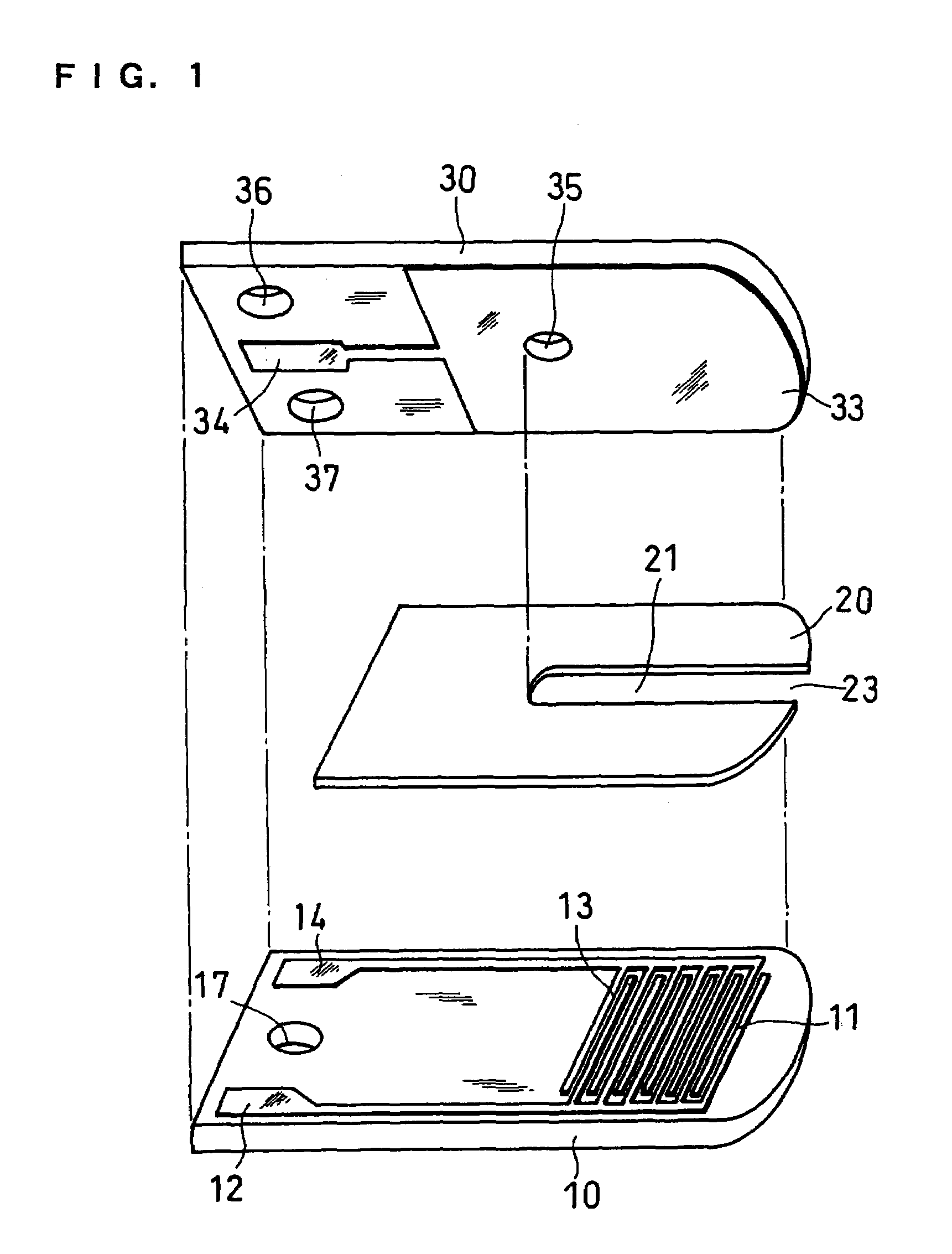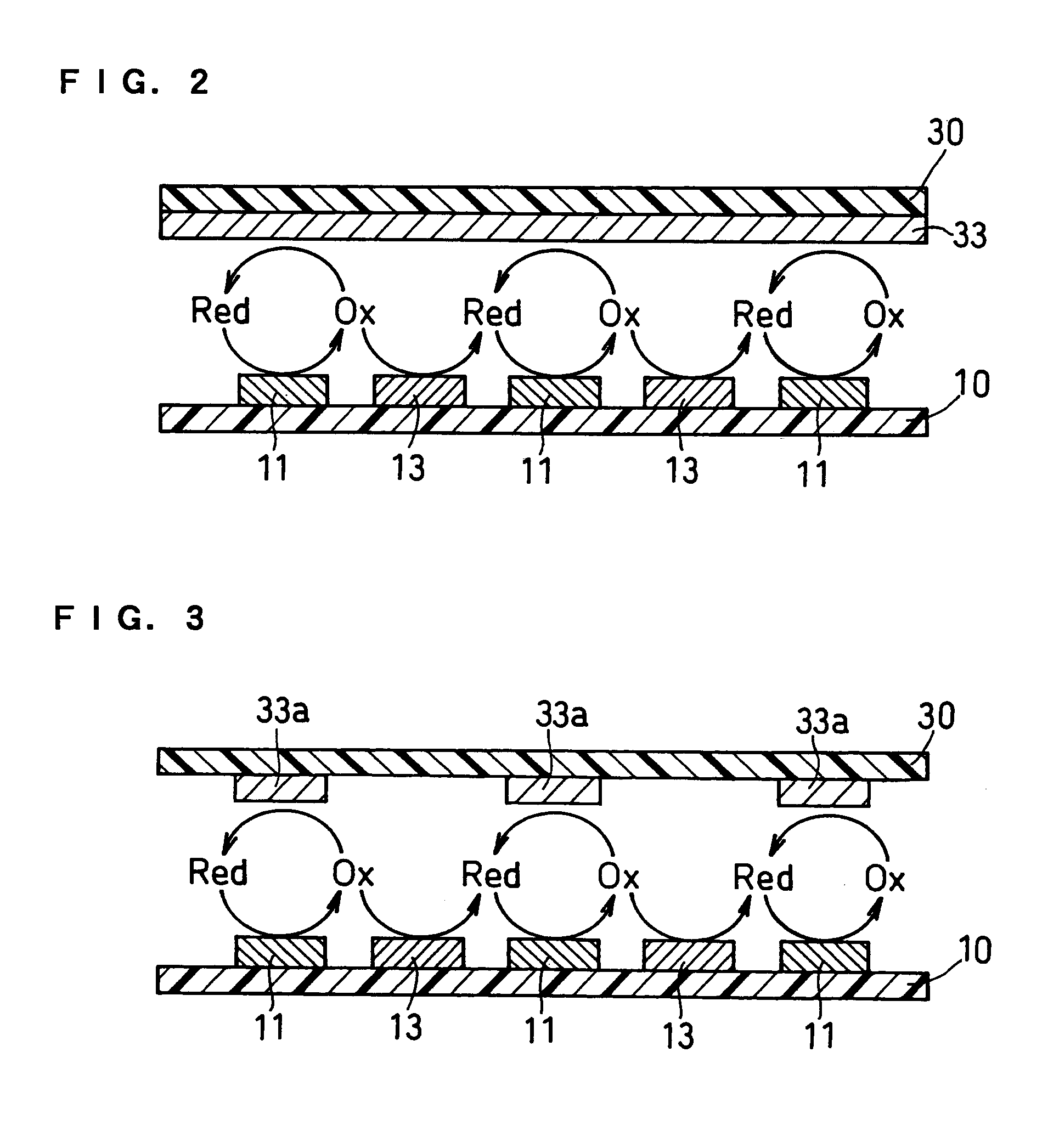Biosensor with interdigitated electrodes
a biosensor and electrode technology, applied in the field of biosensors, can solve the problems of poor accuracy, affecting a large extent, and all poorly specific to sugars
- Summary
- Abstract
- Description
- Claims
- Application Information
AI Technical Summary
Benefits of technology
Problems solved by technology
Method used
Image
Examples
embodiment 1
[0029]FIG. 1 is a longitudinal cross-sectional view of a glucose sensor from which the reagent layer and surfactant layer are omitted in this embodiment.
[0030]10 represents a first base plate comprising an electrically insulating material. On the base plate 10, there is formed, by photo lithography, an electrode system which is composed of a substantially comb-shaped working electrode 11 comprising a plurality of branches and its lead 12 and a substantially comb-shaped first counter electrode 13 comprising a plurality of branches and its lead 14. As a specific method, for example, palladium is sputtered over the base plate, and the palladium film is covered with a resist. Subsequently, the resultant palladium film is provided with masking having the same shape as the electrode system, exposed to light, developed, and etched. Finally, the resist is removed to form an electrode system having a predetermined shape. In this figure, each of the working electrode 11 and the first counter ...
embodiment 2
[0039]FIG. 4 is a decomposed perspective view of a glucose sensor from which the reagent layer and surfactant layer are omitted in this embodiment.
[0040]Following the same procedure as that of Embodiment 1, a first electrode system, which is composed of a substantially comb-shaped first working electrode 41 comprising a plurality of branches, a first working electrode lead 42, a substantially comb-shaped first counter electrode 43 comprising a plurality of branches and a first counter electrode lead 44, is formed on a first base plate 40. On a second base plate 60 is formed a second electrode system, which is composed of a substantially comb-shaped second working electrode 61 comprising a plurality of branches, a second working electrode lead 62, a substantially comb-shaped second counter electrode 63 comprising a plurality of branches and a second counter electrode lead 64. The number of the branches of the working electrode and the counter electrode is not to be limited to the num...
embodiment 3
[0045]FIG. 6 is a decomposed perspective view of a glucose sensor from which the reagent layer and surfactant layer are omitted in this embodiment.
[0046]The structure is the same as that of Embodiment 1 except for the formation of a reference electrode 15 and its lead 16 on a first base plate 10 and formation of an electrically connecting hole 38 for bringing a working electrode lead 12 and the lead 16 of the reference electrode 15 in contact with two corresponding terminals of an apparatus on a second base plate 30.
[0047]In the following, a measuring apparatus for measuring glucose with the use of this sensor will be described with reference to FIG. 9.
[0048]A sensor 80, which was described above, is shown on the left side of FIG. 9. In this figure, only the working electrode lead 12, the lead 16 of the first reference electrode, a counter electrode lead 14 and a lead 34 of a second counter electrode are shown. Meanwhile, a measuring apparatus 81 comprises connectors 72, 96, 74 and ...
PUM
| Property | Measurement | Unit |
|---|---|---|
| voltage | aaaaa | aaaaa |
| width | aaaaa | aaaaa |
| width | aaaaa | aaaaa |
Abstract
Description
Claims
Application Information
 Login to View More
Login to View More - R&D
- Intellectual Property
- Life Sciences
- Materials
- Tech Scout
- Unparalleled Data Quality
- Higher Quality Content
- 60% Fewer Hallucinations
Browse by: Latest US Patents, China's latest patents, Technical Efficacy Thesaurus, Application Domain, Technology Topic, Popular Technical Reports.
© 2025 PatSnap. All rights reserved.Legal|Privacy policy|Modern Slavery Act Transparency Statement|Sitemap|About US| Contact US: help@patsnap.com



